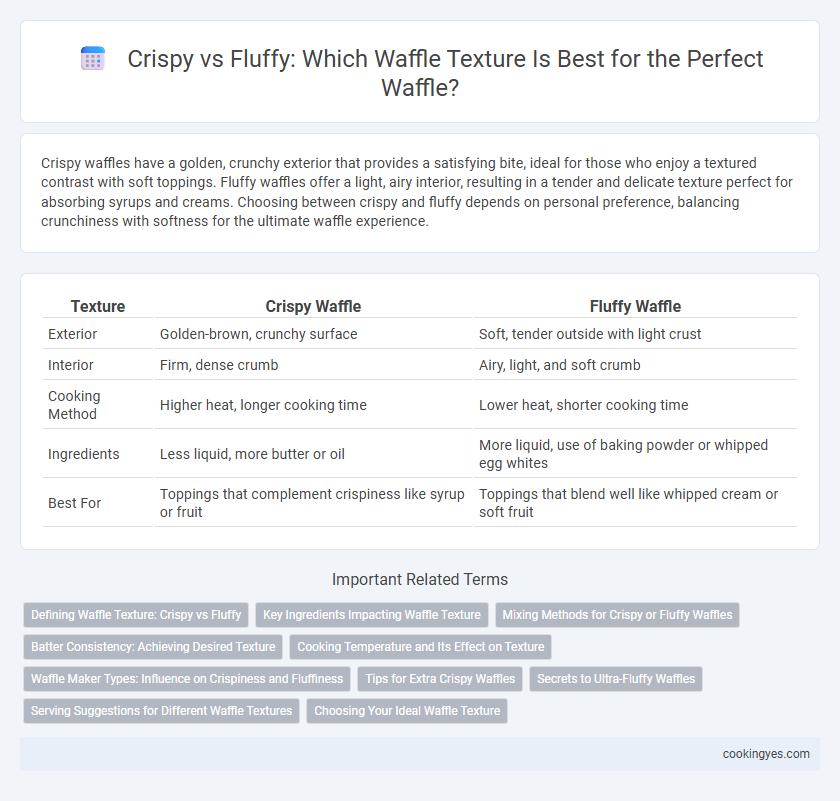Crispy waffles have a golden, crunchy exterior that provides a satisfying bite, ideal for those who enjoy a textured contrast with soft toppings. Fluffy waffles offer a light, airy interior, resulting in a tender and delicate texture perfect for absorbing syrups and creams. Choosing between crispy and fluffy depends on personal preference, balancing crunchiness with softness for the ultimate waffle experience.
Table of Comparison
| Texture | Crispy Waffle | Fluffy Waffle |
|---|---|---|
| Exterior | Golden-brown, crunchy surface | Soft, tender outside with light crust |
| Interior | Firm, dense crumb | Airy, light, and soft crumb |
| Cooking Method | Higher heat, longer cooking time | Lower heat, shorter cooking time |
| Ingredients | Less liquid, more butter or oil | More liquid, use of baking powder or whipped egg whites |
| Best For | Toppings that complement crispiness like syrup or fruit | Toppings that blend well like whipped cream or soft fruit |
Defining Waffle Texture: Crispy vs Fluffy
Waffle texture is primarily defined by the balance between crispiness and fluffiness, where crispy waffles have a golden-brown exterior with a crunchy bite, often achieved through higher heat and less batter moisture. Fluffy waffles feature a soft, airy interior resulting from a batter with more leavening agents like baking powder and whipped egg whites, creating a light and spongy mouthfeel. Understanding the contrast between crispy and fluffy textures helps in customizing waffle recipes to achieve the desired taste and sensory experience.
Key Ingredients Impacting Waffle Texture
Key ingredients such as flour type, baking powder, and fat content significantly influence waffle texture, with higher protein flours promoting crispiness and lower protein flours yielding fluffiness. The amount and type of fat, like butter or oil, contribute to a tender interior and crispy exterior by creating steam during cooking. Baking powder's leavening action leads to air pockets, which enhance fluffiness while excess can cause waffles to become dry and brittle.
Mixing Methods for Crispy or Fluffy Waffles
The mixing method significantly impacts waffle texture, with gentle folding of the batter preserving air bubbles to create a fluffy waffle. For a crispy waffle, the batter is often mixed more thoroughly, incorporating fewer air pockets and using ingredients like melted butter for a denser, crunchier exterior. Techniques such as separating eggs and beating the whites separately before folding them into the batter enhance fluffiness by maximizing volume and lightness.
Batter Consistency: Achieving Desired Texture
Waffle batter consistency is crucial for achieving either a crispy or fluffy texture, with thicker batter typically producing fluffier waffles due to greater air retention and lighter crumb structure. Thinner batter spreads more easily and results in crispier edges as moisture evaporates quickly during cooking. Adjusting liquid-to-flour ratios and incorporating ingredients like beaten egg whites or baking powder directly impacts batter viscosity and the final waffle texture.
Cooking Temperature and Its Effect on Texture
Cooking temperature significantly influences waffle texture; high heat creates a crispy exterior by quickly caramelizing sugars and firming the batter, while moderate heat allows the interior to cook thoroughly, resulting in a fluffy texture. Waffles cooked at temperatures above 375degF tend to develop a golden-brown, crisp crust, whereas lower temperatures around 325degF produce a softer, airy interior. Precise temperature control balances moisture retention and browning reactions, crucial for achieving the desired crispy or fluffy waffle consistency.
Waffle Maker Types: Influence on Crispiness and Fluffiness
Waffle maker types significantly influence the texture, with Belgian waffle makers typically creating thicker, fluffier waffles due to deeper grids that allow batter expansion, while traditional flatiron waffle makers produce thinner, crispier waffles by pressing the batter more evenly. Cast iron waffle makers retain heat consistently, enhancing crispiness, whereas non-stick electric models may yield softer, fluffier results due to lower temperature control. Understanding the impact of waffle maker material and design is crucial for achieving the desired balance between crispy edges and a fluffy interior.
Tips for Extra Crispy Waffles
To achieve extra crispy waffles, use a batter with a higher ratio of sugar and fat, such as melted butter or oil, which caramelizes during cooking to create a crunchy exterior. Incorporate cornstarch or substitute some flour with rice flour to enhance crispiness without compromising fluffiness. Preheat the waffle iron thoroughly and avoid overmixing the batter to ensure light, crispy waffles with a tender inside.
Secrets to Ultra-Fluffy Waffles
Achieving ultra-fluffy waffles hinges on a few key techniques such as separating eggs and whipping the whites to stiff peaks before folding them into the batter, which introduces air and lightness. Using buttermilk or incorporating baking powder and baking soda as leavening agents creates a tender crumb that contrasts with a slightly crispy exterior. Avoid overmixing the batter to maintain air pockets and ensure a soft, airy texture rather than dense or chewy waffles.
Serving Suggestions for Different Waffle Textures
Crispy waffles pair excellently with syrup, fresh berries, and a dollop of whipped cream to enhance their crunchy texture, offering a delightful contrast. Fluffy waffles serve as the perfect base for rich toppings like melted chocolate, peanut butter, or creamy yogurt, complementing their soft, airy crumb. Both textures work well with savory options such as fried chicken or smoked salmon, catering to diverse flavor preferences.
Choosing Your Ideal Waffle Texture
Crispy waffles feature a golden-brown exterior with a satisfying crunch, ideal for those who enjoy a textured bite and contrast with toppings like syrup or fruit. Fluffy waffles have a soft, airy interior that absorbs flavors well, perfect for a lighter, melt-in-the-mouth experience. Selecting your ideal waffle texture depends on whether you prefer a crunch-enhanced contrast or a tender, soft base for your favorite accompaniments.
Crispy vs Fluffy for waffle texture Infographic

 cookingyes.com
cookingyes.com